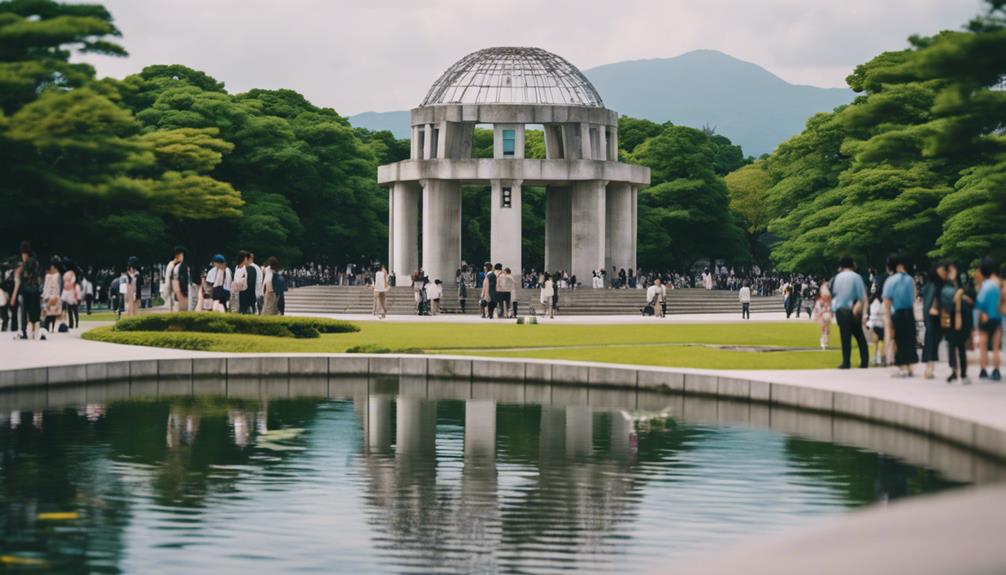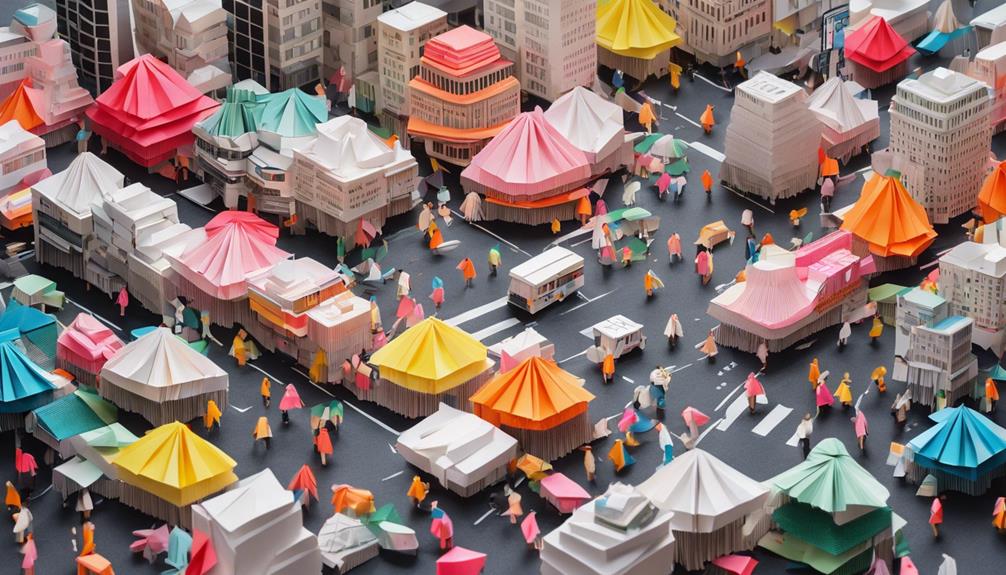Immerse yourself in Hiroshima's diverse history and rich cultural tapestry. From its ancient Jomon origins to the poignant City of Peace designation post-1949, each corner tells a story. Discover the well-preserved Edo-period charm of Tobishima Kaido Mitarai Townscape, walk through the historical reflections in Irifuneyama Memorial Hall, and step back in time at Kagura Monzen Toji Mura. Encounter feudal remnants at Sengoku Garden History Museum and explore the enchanting heritage of Takehara with the Sightseeing Bus Tour. Engage in traditional tea ceremonies with English explanations and uncover the history of the powerful Kikkawa Clan at the museum. Explore further to uncover hidden gems.
Key Takeaways
- Visit Peace Memorial Park & Atomic Bomb Dome for historical reflection.
- Explore Tobishima Kaido Mitarai Townscape for Edo-period charm.
- Immerse in Kagura Monzen Toji Mura's old Showa era ambiance.
- Discover history at Sengoku Garden History Museum and Takehara Townscape.
- Engage in tea ceremonies and museum exhibits for cultural experiences.
Hiroshima's Antiquity and Feudal Times

Hiroshima's history dates back to ancient times, with its roots reaching the Jomon era and evolving into a city officially recognized in 1589 during feudal Japan. During the Edo period, Hiroshima thrived under the rule of the Asano clan, who transformed it into a significant stronghold under their powerful leadership. The city's strategic location made it a vital military center during various conflicts, including World War I and World War II.
The Asano clan's governance over Hiroshima lasted until 1871 when the feudal system was abolished in Japan. Hiroshima's shift from a feudal stronghold to a modern city was marked by significant events, none more impactful than the atomic bombing in 1945.
This tragic event reshaped Hiroshima's landscape and its trajectory, leading to the establishment of Peace Memorial Park and Museum, solidifying its identity as a City of Peace dedicated to promoting peace and nuclear disarmament.
Hiroshima in the 19th Century

With growing economic and industrial advancements, Hiroshima solidified its position as a key player in Japan during the 19th century. The history of Hiroshima in the 1800s was marked by significant developments that shaped its trajectory in Japanese history.
As the capital of the prefecture during the Meiji era, Hiroshima's importance was underscored. The 1880s saw a surge in economic and industrial growth, leading Hiroshima to specialize in cotton and weapons production, further solidifying its role in the region.
Moreover, Hiroshima's strategic significance grew as it became a prominent military center during World War I. This evolution as an essential military base continued into World War II, profoundly influencing Hiroshima's modern history.
The events of the atomic bomb in 1945 marked a pivotal moment in Hiroshima's narrative, steering its path towards becoming a City of Peace. The 19th century laid the foundation for Hiroshima's future, cementing its historical significance in Japanese history.
Hiroshima: City of Peace

Amidst the remnants of a tragic past, Hiroshima stands as a beacon of peace and resilience in the modern world. Designated as a City of Peace in 1949, Hiroshima has been at the forefront of advocating for global peace and nuclear disarmament.
The city's Peace Memorial Park, established to commemorate the victims of the atomic bombing, stands as a solemn reminder of the devastation caused during World War II. At the heart of the park lies the iconic Atomic Bomb Dome, a UNESCO World Heritage Site that symbolizes Hiroshima's commitment to peace and reconciliation.
Notable figures, including former U.S. President Barack Obama, have visited Hiroshima to pay respects to the victims and honor the city's dedication to peace. The annual Hiroshima Peace Memorial Ceremony, held on August 6, serves as a poignant event to remember the lives lost and to promote a message of peace to the world.
Hiroshima's unwavering commitment to fostering a culture of peace continues to inspire nations globally.
Tobishima Kaido Mitarai Townscape

Explore the Tobishima Kaido Mitarai Townscape Preservation District to immerse yourself in the historical charm of this Edo-period Japan Heritage town. As you wander through the streets of Mitarai, you'll be transported back in time to experience the traditional architecture and atmosphere of a bygone era.
The Tobishima Kaido, a historic road connecting Hiroshima and Okayama, runs through this picturesque town, offering a glimpse into the past. The well-preserved buildings and storefronts in the district showcase the rich history and cultural significance of Mitarai.
Strolling through the town, you'll encounter various landmarks such as the Mitarai Merchant Museum and the former residences of wealthy merchants, providing insights into the economic prosperity of the region during the Edo period.
Don't miss the opportunity to visit the Mitarai Furusato Village to learn more about the local customs and traditions that have been passed down through generations. Immerse yourself in the authentic ambiance of Tobishima Kaido Mitarai Townscape, a hidden gem that encapsulates the essence of historical Japan.
Irifuneyama Memorial Hall

When visiting the Irifuneyama Memorial Hall, you'll have the opportunity to explore a wide array of exhibits that reflect on the tragic events of history.
The artifacts and displays within the hall offer a poignant glimpse into the impact of past events on the region.
Engaging with these exhibits allows for a deeper understanding of the historical significance of the Kure Naval Station and its role in Japan's maritime past.
Memorial Hall Exhibits
Visitors to the Irifuneyama Memorial Hall can explore the rich naval history of the Kure Naval Station through its collection of valuable artifacts and exhibits. The Memorial Hall, once the official residence of the Commander-in-Chief, offers insights into the military leadership and operations during its active period.
Here are some highlights to look out for:
- Rare Gold Wallpaper: The Commander's office is adorned with rare gold wallpaper, reflecting the historical luxury of the era.
- Valuable Artifacts: The hall houses a wide array of valuable artifacts that provide a glimpse into the significance of the Kure Naval Station in Japan's naval history.
- Military Operations: Through exhibits and displays, visitors can investigate the strategic military operations carried out at the Kure Naval Station.
Reflecting on Tragedy
Reflect on the somber history of Hiroshima's maritime heritage by visiting the Irifuneyama Memorial Hall, where tragedy and resilience intersect in the shadow of its military past. During World War II, Hiroshima Prefecture bore witness to the devastating effects of conflict, with the Irifuneyama Memorial Hall standing as a poignant reminder of the region's wartime experiences.
Once serving as the Official Residence of the Commander-in-Chief of the Kure Naval Station, this historic site encapsulates the profound impact of historical events on Hiroshima's naval history. As you explore the hall, you'll encounter rare gold wallpaper adorning the former Kure Naval Station Commander's office, offering a glimpse into the prestigious past of this establishment.
Delving into the Edo period and the pivotal role of the Kure Naval Station, visitors can gain a deeper understanding of Hiroshima's maritime legacy. The Irifuneyama Memorial Hall provides a unique perspective on the region's military history, inviting reflection on the tragedies of the past while celebrating the resilience of the human spirit.
Kagura Monzen Toji Mura

Nestled in Hiroshima, Kagura Monzen Toji Mura invites you to step back in time to the nostalgic world of the old Showa era. As you explore this cultural gem, be prepared to immerse yourself in a unique experience that combines traditional architecture and radon hot springs, offering a serene environment for relaxation.
Unordered list to grab attention:
- Discover the charm of the past through well-preserved historic buildings.
- Unwind in the rejuvenating radon hot springs, perfect for a soothing retreat.
- Immerse yourself in the traditional atmosphere of Kagura Monzen Toji Mura, a hidden treasure in Hiroshima.
With its historic buildings and hot springs, Kagura Monzen Toji Mura provides a glimpse into Japan's rich heritage. This site allows you to wander through a bygone era, appreciating the intricate details of traditional Japanese architecture and experiencing the serene ambiance it offers.
Truly a hidden gem in Hiroshima, Kagura Monzen Toji Mura promises a cultural journey that transports you to a different time, allowing you to connect with Japan's past in a meaningful way.
Sengoku Garden History Museum

When you visit the Sengoku Garden History Museum, you'll encounter a diverse array of exhibits that offer an in-depth overview of the Kikkawa Clan's heritage.
These exhibits not only showcase the remnants of the Okgurayama Castle but also provide valuable cultural insights into the Sengoku period.
As you explore the museum, you'll gain a deeper understanding of the military strategies and lifestyle of the Kikkawa Clan during the feudal era.
Museum Exhibits Overview
At the Sengoku Garden History Museum, explore the intriguing remains of the Kikkawa Clan Okgurayama Castle in Hiroshima. Uncover the rich history of the powerful Kikkawa Clan through a variety of historical artifacts and exhibits on display.
Here are some highlights of what you can expect:
- Investigate the historical artifacts and exhibits related to the influential Kikkawa Clan, offering a glimpse into their role in shaping Hiroshima's history.
- Gain insights into the feudal era and the significance of the Kikkawa Clan in the region's development.
- Learn about the strategic importance of the Okgurayama Castle remains and its impact on the local history and culture of Hiroshima.
The Sengoku Garden History Museum provides a unique opportunity to explore the past and appreciate the cultural heritage of Hiroshima through the lens of the Kikkawa Clan.
Cultural Insights Shared
Explore fascinating cultural insights at the Sengoku Garden History Museum in Hiroshima, where the legacy of the Kikkawa Clan comes to life through immersive exhibits and artifacts. Investigate the remains of the Kikkawa Clan Okgurayama Castle, offering a glimpse into the clan's history during the Sengoku period in Japan. The museum provides visitors with a unique opportunity to examine the military strategies and lifestyle of the Kikkawa Clan rulers through a diverse range of exhibits.
Immerse yourself in the historical artifacts on display, showcasing the rich heritage of Hiroshima's feudal past and the significant role played by the Kikkawa Clan. Gain insights into the cultural practices and traditions of this influential clan, offering a deeper understanding of the region's historical development.
Takehara Sightseeing Bus Tour

Immerse yourself in the enchanting heritage of Takehara through the guided exploration offered by the Takehara Sightseeing Bus Tour. This tour takes you to the Japan Heritage Site Takehara Townscape Preservation District, where you can admire the well-preserved traditional buildings and explore the town's rich history.
The excursion also includes a visit to Okunoshima Island, renowned for its serene beauty and historical significance. On this journey, knowledgeable guides will accompany you, providing insights into the world heritage sites and ensuring a deeper understanding of the cultural significance of the region.
- Discover the charm of Takehara's traditional buildings and historical sites.
- Explore the Japan Heritage Site Takehara Townscape Preservation District.
- Visit Okunoshima Island, known for its historical importance and natural beauty.
Embark on this insightful and convenient bus tour to experience the unique attractions of Takehara in Hiroshima.
Tea Ceremony and Cultural Experiences

Explore the essence of Japanese culture by experiencing traditional tea ceremonies in Hiroshima. These ceremonies go beyond just a beverage; they embody harmony, respect, and tranquility. Visitors have the opportunity to partake in these rituals with English explanations, delving into the history and intricate customs involved.
What sets Hiroshima's tea ceremony experiences apart is the attention to dietary preferences. Whether you're a vegetarian, vegan, or seeking halal meals, options are available to cater to your needs.
Moreover, Hiroshima's tea ceremony culture integrates various elements, including history, aesthetics, and even visits to local sake breweries. It's not just about the tea; it's a holistic cultural immersion. These tea gatherings often include bento box meals and sake, offering a complete experience that truly captures the essence of Japanese tradition.
Immerse yourself in the tranquility and beauty of a traditional tea ceremony in Hiroshima, where every detail contributes to a profound cultural experience.
Frequently Asked Questions
What Is the Historical Significance of Hiroshima?
Hiroshima holds immense historical significance due to being the first city where an atomic bomb was dropped during World War II.
This event marked a turning point in warfare and human history.
The devastation caused in Hiroshima serves as a stark reminder of the horrors of nuclear weapons and the importance of promoting peace worldwide.
The city's resilience and commitment to peace make it a powerful symbol of hope and remembrance.
Why Is Hiroshima a Turning Point in World History?
Hiroshima stands as a pivotal moment in global history due to being the first city struck by an atomic bomb in 1945.
The catastrophic effects of this event reverberated worldwide, leading to a significant loss of life and widespread devastation.
Japan's subsequent surrender marked the conclusion of World War II.
The city's post-bombing reconstruction efforts and its eventual designation as a City of Peace underscore its enduring significance in promoting global peace and nuclear disarmament.
What History of War Was Hiroshima?
Hiroshima's history of war is deeply rooted in the tragic events of August 6, 1945, when the city became the target of the first atomic bomb used in warfare.
This devastating attack during World War II resulted in widespread destruction and loss of life, marking a turning point in global conflict.
The aftermath of the bombing led to Japan's surrender and the beginning of the end of the war, shaping the course of history.
How Did Hiroshima Become a Part of World History Answer?
Hiroshima became a part of world history due to the tragic events of August 6, 1945, when it became the first city to endure an atomic bomb during World War II.
The devastating impact of this event not only shaped the city's identity but also served as a global symbol of peace and the dangers of nuclear warfare.
Hiroshima's subsequent transformation into a City of Peace solidified its place in history as a beacon for promoting peace, nuclear disarmament, and reconciliation.
Conclusion
To sum up, Hiroshima offers a rich tapestry of history and culture for visitors to explore. From its ancient roots to its modern-day commitment to peace, the city provides a unique and immersive experience for those seeking to understand its past.
With a variety of historical sites, museums, and cultural activities, there's no shortage of opportunities to explore Hiroshima's fascinating heritage.
As the saying goes, 'History isn't a burden on the memory but an illumination of the soul.'










